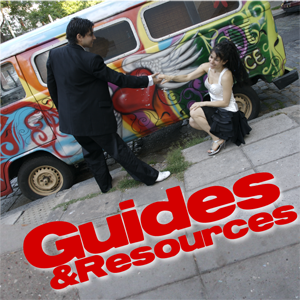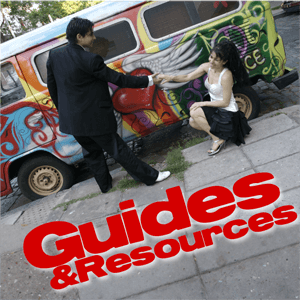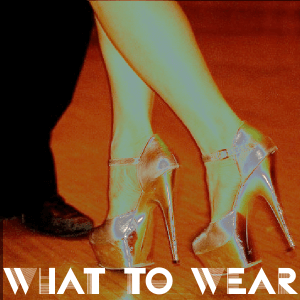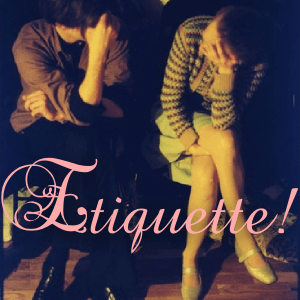by Nick Young
In this musicality session, we look at 3 different techniques of dancing slowly by skipping beats that we might normally step on.
Now, we only look at how to skip beats using these techniques. Later, we will look at when or which beats to skip.
It is important for the mark to understand these ideas so that he can lead them. It is important for the revel to understand how these ideas require her to have good technique – e.g. not automatically collecting, to enable paradas – so that the mark can use these ideas to dance musically.
Two reasons to try dancing slowly:
- To express yourself / the music.
- To make fast/challenging music mentally and physically easier.
Skipping beats
- This is not about dancing to slow music. This is about dancing to fewer beats, regardless of the speed of the music, including fast music.
- These methods all skip beats in different ways.
First way to skip beats: Pausing
- Make a single step at normal speed over one beat. Then, simply wait any number of beats before stepping again.
- Why?
- Gives you time to collect yourself and decide what to do next.
- Gives you time to catch the next beat, or the next, rather than rushing to catch this one. Let the music come to you.
- To make space for some little musical detail that you know is in the song.
- To simply enjoy the connection that’s invisible to everyone but you and your partner.
- Technique:
- Complete the usual flexion, projection, extension base leg + transfer weight, re-establish arch of connection through new base leg. Then just pause.
- //tangoforge.com/knowledge-base/step/
- Paul’s tip:
- We don’t need to completely stop moving, stiff, while pausing. This is an ideal time for small boleos, especially during long pauses, or just enjoy gently playing with the connection that you’ve re-established.
Second way to skip beats: Slow-motion
- Make a single step in slow motion over multiple beats. Repeat smoothly, without pausing, any number of times before returning to normal speed.
- Why?
- Gives you time breathing room to collect yourself in fast, relentless music, when a complete pause might not feel right.
- Works kind of like a slur in music that smooths out a melody over multiple beats – good when the beats are clear, but all equal power.
- We are often taught to always find our own balance (axis) on one foot, and there’s a danger of thinking that all we ever want to do is get to that next foot, and that the bits in between – flexion, projection, etc – exist only to get us there. But in reality there’s an infinite continuum of possibilities and sensations in between each step. This method of dancing slowly acknowledges and celebrates those moments.
- It looks and feels really cool. (Especially when you return to normal speed at the end; the release of tension built up over the forced slowness!)
- Technique:
- Normal technique for a step, but very slow. No pauses between elements (flexion etc); everything slowed down equally.
- Very difficult, but excellent to practice! Feel muscles in foot (especially toes) and core engage like never before to keep you stable.
- Forward steps normally have a moment of dynamic instability as we fall onto the next foot using gravity. This moment cannot be slowed down (gravity won’t wait for us), but it can be minimised.
- But you MUST maintain correct technique of shoulders in front of hips. Don’t let your upper body lean back in an attempt to counterbalance the forwards-projected foot and leg. Solution? LOTS of hip flexion!
- Back steps don’t have this moment of dynamic instability (the weight of the backwards-projected leg can be fully counterbalanced by the weight of the shoulders being properly in front of hips), so use the arch of connection with your stable partner to help each other!
- Paul’s tip:
- Try playing with that space in between steps, when your weight is solidly on both feet (when normally we’re taught never to be on two feet!). Try rocking forward and back, try sinking down (like a forward lunge exercise).
- Nick’s tip:
- When playing in the space between steps, I think of it like rewinding and replaying a short movement on loop. Try rewinding a very small range of the overall motion in the exact middle of the step.
Third way to skip beats: Punctuated-slow-motion
- Make a very strong, accelerating step to hit the beat hard, but as soon as the foot lands on the beat, hold it – don’t fully transfer weight. Hold and play, or when ready finish the step in slow motion over multiple following beats.
- Why?
- To express one particular beat of the music very strongly. You make a strong step on the beat itself, and then slow right down over subsequent beats to increase contrast even more.
- When one beat is especially strong, hitting just that one beat can be enough to sustain an entire bar of slow movement.
- A great way of easily dancing fast songs with strong beats, such as milonga, while still being very fun.
- Looks super-cool.
- Technique:
- For full effect, you want to hit the strong beat just as your foot lands. That means starting the flexion and projection of the step just before the beat (say a half or a quarter beat early).
- To practice hitting the beat, try counting the beat as “one-and-two-and-three-and-four-AND-BOOM!”, where you’re patiently waiting out the beats one through four, you start flexion on the final “AND” and hit the beat with your step on “BOOM!”
- Make the step very strong and sharp. Really drive with the base leg, feel the quads and calf muscles working!
- Note! only make the step itself sharp – remember you must provide gentle smooth flexion and projection before the step; don’t shove suddenly!
- Hold the step using parada technique: decelerate hard but smoothly as soon as your foot makes contact. Do not fully extend your old base leg, because that would transfer weight onto the new foot. The revel should not automatically transfer weight fully, but should stay with the mark, with weight split between both feet.
- //tangoforge.com/knowledge-base/parada/
- Stay down and grounded after the parada. The hard deceleration might actually take you a tiny bit deeper into flexion (sinking down), as it absorbs the power from the very strong step.
- Use the next few beats to very slowly extend the old base leg fully, slowly transferring weight fully onto the new foot and coming up, ready to begin flexion and projection for the next explosive step. Take as long as you like, don’t stress. If you miss the next strong beat, you can always wait for the next one to come around and be ready for it.
- For full effect, you want to hit the strong beat just as your foot lands. That means starting the flexion and projection of the step just before the beat (say a half or a quarter beat early).
- Paul’s tip:
- The initial step is similar to the very strong walking steps that we use to music like Pugliese’s La Yumba, Zum, and Pata Ancha. We gently start the forward projection, then drive hard and fast with the base leg, and slow down over the weight transfer and collection.
- Nick’s tip:
- This method is a little bit like, dare I say it, dubstep – where the dancer hits a beat hard and then instantly knocks it down into slow-motion for a phrase of music, before snapping back into normal time.
- Like the slow-motion step above, once you’ve made the step and held it in parada, try playing with that infinite continuum between steps by rocking, sinking, rewinding, and replaying.
Challenges:
- Dance one song using nothing but simple linear front, back, and side steps. Use these methods of dancing slowly to make this dance the most beautiful you’ve ever had.
- Use all three methods of dancing slowly within the one song to create interestingly contrasting sensations!
- Listen to you favourite music and visualise dancing using these three methods in different sections – long pauses, sustained slow-motion, and punctuated slow motion.













